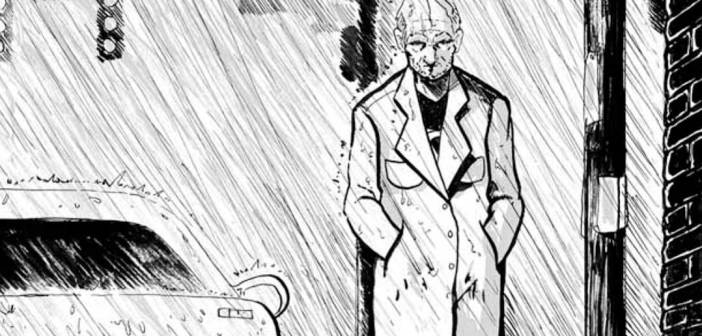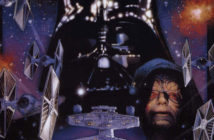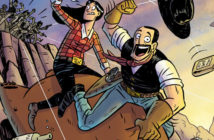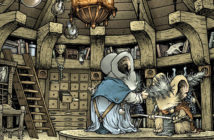29-year-old Jeremy Massie knows what he wants out of life and he’s going after it—a career in comics. His love for comics began at a young age when he loitered around his local drug store reading about the adventures of Superman. These stories inspired him to begin creating his own at a young age, and his aspirations ran wild ever since. He first attended college at Virginia Commonwealth University, but later moved to the Savannah College of Art and Design where he studied sequential art, the code word in academia for comic books.
Now Massie works by day as a graphic designer for a newspaper, the Coalfield Progress, while he creates comics by night. His first graphic novel, “The Deadbeat,” was published by Alterna Comics (www.alternacomics.com) in May 2009. When he’s not working on his art, he enjoys spending time with his wife, Betsy, and their dachshund, Sonny.
I recently had an opportunity to speak with Massie about “The Deadbeat,” as well as the finer details of why he loves comics so much and where he pulls inspiration from.
Steven Surman: To begin, could you talk a little bit about your experience as a writer and artist?
Jeremy Massie: I started drawing very early. I was really into the movie “Superman.” I drew Superman all the time. When I learned to read I discovered Superman comics at my local drug store. I drew my first comic at [age]11 or 12. I only had the original art, so I stapled it together and rented it to my classmates for 50 cents a pop. I’ve been doing comics ever since.
After discovering the indie comics scene thanks to “Love & Rockets,” “Hate,” “Eightball,” and “Yummy Fur,” I started making mini comics. I was a devout patron of Kinko’s all through college. I got kicked out of the first college I went to, but found a school where I could major in comics, down in Savannah Georgia. I had teachers that really changed the way I did things. Teachers like John Lowe, Mark Kneece, and Ted Stearn were tremendously helpful in showing me not only the techniques of the medium, but the formal aspects of it as well. After graduation, I continued making mini comics. Eventually, I decided to begin my first graphic novel.
SS: What are some of your favorite comic titles that you’ve drawn inspiration from over the years?
JM: As I said, I was a huge “Superman” fan. I loved Chris Claremont, Dave Cockrum, and John Byrne’s X-Men stuff. The discovery of graphic novels was big for me. “Ghost World” was a huge jolt to my system, as was “I Never Liked You” by Chester Brown. Mini comics were also a huge inspiration. The “do it yourself” mentality is something I love. Most of the money I spend at conventions is on minis. I really love Jason Shiga, and I am addicted to this book called “Breathers” by Justin Madson. There’s a lot of stuff out there. I like variety. I love finding new stuff.
SS: When did you first decide you were going to take a leap and create your own comic book, “The Deadbeat”?
JM: It was just a natural progression. My stories were getting longer and longer. I got it in my head that I wanted to do a superhero story, after discovering a lot of Silver Age DC stuff. But, I wanted to do a superhero story my way. I like character-driven stories and come from this mini/indie comics background. So, “The Deadbeat” was kind of a weird marriage of indie and mainstream sensibilities.
SS: Where did the idea for “The Deadbeat” come from?
JM: All of my stories come from my own experiences or from observing people close to me. Even if the stories have fantasy or sci-fi elements, they still have to be connected to me in some sort of familiar or emotional way.
SS: How long did it take you to finish “The Deadbeat”?
JM: A little longer than it should have. Once Alterna agreed to publish it though, I was like the Flash!
SS: Once you finished creating the book, what was the process like to find a publisher for The Deadbeat?
JM: I ran into a few of the Alterna guys at S.P.A.C.E., a convention in Ohio. Alterna really reminded me of the Island of Misfit Toys. Everything they put out was great and different, but was really hard to label or categorize. That makes things hard when you are trying to get something published. I ran into that problem and decided it might work out with them. I sent Peter Simeti a submission and he dug the idea. That was that.
SS: If you were to summarize the plot of “The Deadbeat,” how would you describe it?
JM: It’s a slice of super life story, about a down on his luck former superhero and his estranged daughter repairing the rift between them. And I’d also like to say—it’s awesome!
SS: When I originally reviewed “The Deadbeat,” I noticed that the character of Vera was a compelling feminist figure, but not one that would cause any of your male readers to uncomfortably cross their legs. Tell me more about the creative process that went into creating Vera.
JM: Vera is based on two people I’m close to. I just took some things from them and turned it up a gazillion notches. The portrayal of the fairer sex in superhero books still needs some work, though it has gotten much better. Indie comics are miles ahead in that department. Since I was exposed to a lot of indie comics in the 1990s, I think that helped out with how I write female characters.
A lot of superhero comics back then were embarrassing on a lot of levels, their portrayal of women especially. I think they are still trying to shake some of that. It’s still out there though, women are either objectified, or like you mentioned, turned into ball-busting caricatures. It is way better, though. That’s good for everybody. Go to a convention and look around. Women are everywhere, behind the tables and shopping—it’s awesome!
SS: I’m kind of a fan of the Spook; I think the costume did it for me. Though he’s not in the story much, he reminds me of a combination of Batman and the Shadow. Where did you come up with him?
JM: Yeah—Batman, the Shadow, and the Spirit. I’m working with a lot of archetypes in “The Deadbeat.” I wanted to use that kind of character. I just grabbed him out of a sketchbook. When I started writing my next book he came up again. He’s not the main character but you get to know what’s under the mask if you stick with me.
I really like him, too. It’s strange how organic writing and drawing this stuff becomes. I didn’t have any plans for him, and then I ended up creating an entire history for him.
SS: “The Deadbeat” is being marketed as a comic book for young adults. What prompted you to write a comic for a younger audience?
JM: Since college, I’ve been doing comics with plenty of adult stuff going on. I wanted “The Deadbeat” to be something anyone could read. Its about things that are so common nowadays, I wanted it to be very accessible. Even people who don’t read comics can get in on it, hopefully.
SS: Something I admired about your work on “The Deadbeat” was your capability as both a writer and an artist; a skill set that I feel is rather rare in comics. Is there a part of the creative process you enjoy more between writing and illustrating?
JM: I really like them both. The thing that’s the most enjoyable is the finished product. The no-hassle way of getting that final product is to just do it all yourself. I don’t write traditional scripts. If you’ve ever seen the movie “American Splendor,” Harvey Pekar writes his comics by doing layouts; I kind of do it that way. I just start sketching these rough layouts, trying to figure out the pacing. Then refine it until I get to the finished page. The whole process involves drawing because it’s easier for me. If I were to sit down and type out a script it would be a waste of time for me because it would just add an extra step. I would eventually sit down and start laying out the typed script anyway, so why bother. You can write this way if you work alone.
SS: An aspect of your comic that I admired artistically was the sequential use of panels; you didn’t really have any large splash shots that burst out of any panels. Could you explain the artistic process that when into “The Deadbeat”?
JM: I like things simple. A lot of people are able to get really wild with panel layouts and make it work, guys like Neal Adams or Chris Ware. Sometimes people try to do this and really screw up. If a reader gets lost on the page and they go to the wrong panel, you’ve totally taken them out of the story. I find sticking with a three or four tier panel grid just makes it easier to control the rhythm of the story. Panel borders and gutters have worked for years, so I love them. What goes on between panels in those gutters are where the reader comes in. They actually have to become involved and fill in the blank spaces in time.
Superhero comics tend to exaggerate everything when it comes to the art. Knowing when to exaggerate and when to hold back is very important. I really like Darwyn Cooke because of that. He can draw with the best of them but his layouts and style are really simple.
While The Deadbeat exists within the superhero genre, it seems to use it more as a backdrop in discussing average, contemporary problems that we all face as normal people. Because you’re working with different techniques and messages in the story, what do you hope readers will take away from your book?
I mentioned cartoonists like Daniel Clowes and Chester Brown who really got me into telling stories about emotional conflicts as opposed to physical ones. The comics I did before I did “The Deadbeat” were about every-day life. Though “The Deadbeat” is a superhero book, I still wanted it to retain the qualities I favor. At the very least the story may provide an escape for someone. Maybe it’ll affect someone on an emotional level. Who knows? The worst thing that can happen is a reader will give it a quick glance and forget about it twenty minutes later. I’d rather someone absolutely hate it than just forget it.
SS: Would you ever consider collaborating with an outside writer or artist on a future project?
JM: Yeah. Know anybody? Email me.
SS: What are you working on next?
JM: A series of three graphic novels called AMATEURS. There’s a preview image of it up on my blog.
This interview originally appeared on Comic News in 2009.




